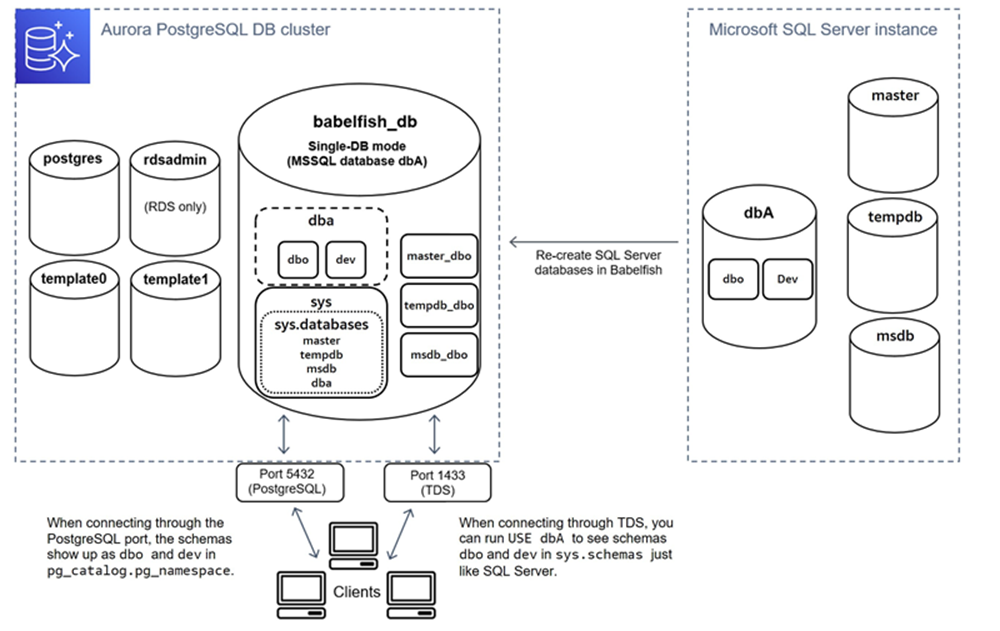Babelfish architecture
When you create an Aurora PostgreSQL cluster with Babelfish turned on, Aurora provisions
the cluster with a PostgreSQL database named babelfish_db. This database is
where all migrated SQL Server objects and structures reside.
Note
In an Aurora PostgreSQL cluster, the babelfish_db database name is reserved for Babelfish. Creating
your own "babelfish_db" database on a Babelfish DB cluster prevents Aurora from successfully provisioning Babelfish.
When you connect to the TDS port, the session is placed in the
babelfish_db database. From T-SQL, the structure looks similar to being
connected to a SQL Server instance. You can see the master, msdb,
and tempdb databases, and the sys.databases catalog. You can
create additional user databases and switch between databases with the USE statement.
When you create a SQL Server user database, it's flattened into the
babelfish_db PostgreSQL database. Your database retains cross-database
syntax and semantics equal to or similar to those provided by SQL Server.
Using Babelfish with a single database or multiple databases
When you create an Aurora PostgreSQL cluster to use with Babelfish, you choose between
using a single SQL Server database on its own or multiple SQL Server databases
together. Your choice affects how the names of SQL Server schemas inside the
babelfish_db database appear from Aurora PostgreSQL. The migration mode
is stored in the migration_mode parameter. You must not change this parameter after
creating your cluster as you could lose access to all your previously created SQL objects.
In single-db mode, the schema names of the SQL Server database remain the same in the
babelfish_db database of the PostgreSQL. If you choose to migrate only a single database,
the schema names of the migrated user database can be referenced in PostgreSQL with the same
names used in SQL Server. For example, the dbo and smith schemas reside inside the
dbA database.

When connecting through TDS, you can run USE dba to see schemas dbo and
dev from T-SQL, as you would in SQL Server. The unchanged schema names are also
visible from PostgreSQL.
In multiple-database mode, the schema names of user databases become
dbname_schemaname when accessed from PostgreSQL. The schema names
remain the same when accessed from T-SQL.

As shown in the image, multiple-database mode and single-database mode are the same
as SQL Server when connecting through the TDS port and using T-SQL.
For example, USE dbA lists schemas dbo and
dev just as it does in SQL Server. The mapped schema names, such as dba_dbo
and dba_dev, are visible from PostgreSQL.
Each database still contains your schemas. The name of each database is prepended to the name of the SQL Server schema, using an underscore as a delimiter, for example:
-
dbacontainsdba_dboanddba_dev. -
dbbcontainsdbb_dboanddbb_test. -
dbccontainsdbc_dboanddbc_prod.
Inside the babelfish_db database, the T-SQL user still needs to run USE
dbname to change database context, so the look and feel remains similar
to SQL Server.
Choosing a migration mode
Each migration mode has advantages and disadvantages. Choose your migration mode based on the number of user databases you have, and your migration plans. After you create a cluster for use with Babelfish, you must not change the migration mode as you might lose access to all your previously created SQL objects. When choosing a migration mode, consider the requirements of your user databases and clients.
When you create a cluster for use with Babelfish, Aurora PostgreSQL creates the system
databases, master and tempdb. If you created or modified
objects in the system databases (master or tempdb), make
sure to recreate those objects in your new cluster. Unlike SQL Server,
Babelfish doesn't reinitialize tempdb after a cluster
reboot.
Use single database migration mode in the following cases:
-
If you are migrating a single SQL Server database. In single database mode, migrated schema names when accessed from PostgreSQL are identical to those in original SQL Server schema names. This reduces code changes to existing SQL queries if you want to optimize them to run with a PostgreSQL connection.
-
If your end goal is a complete migration to native Aurora PostgreSQL. Before migrating, consolidate your schemas into a single schema (
dbo) and then migrate into a single cluster to lessen required changes.
Use multiple database migration mode in the following cases:
-
If you want the default SQL Server experience with multiple user databases in the same instance.
-
If multiple user databases need to be migrated together.